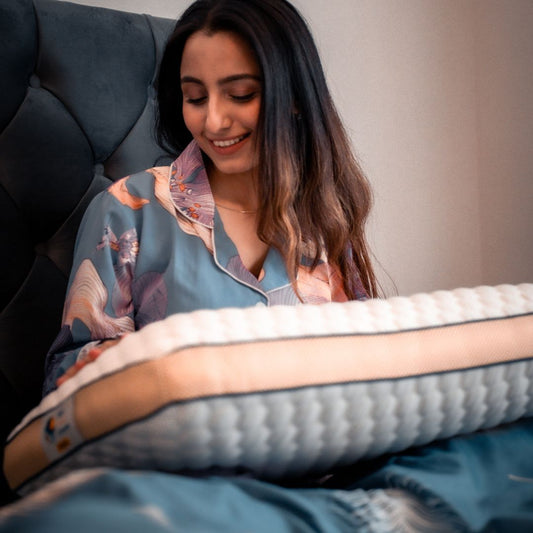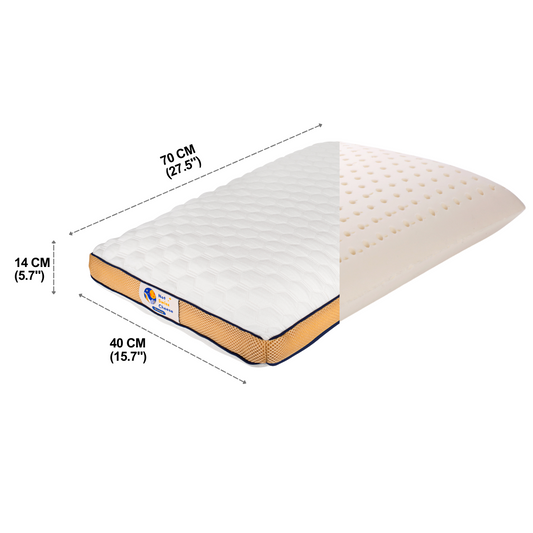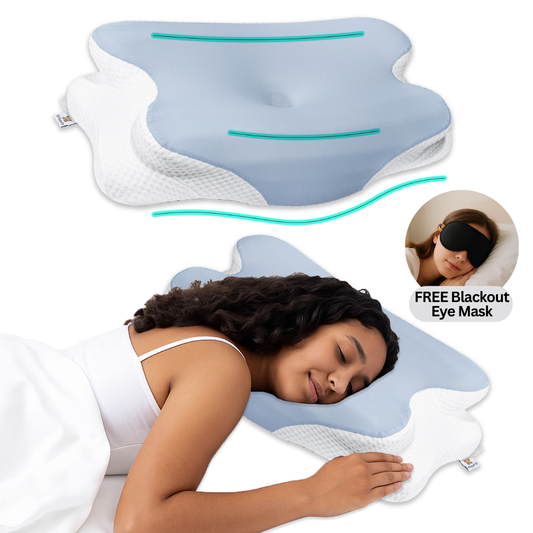Research shows that 7–8 hours of sleep per night is ideal for adults. Sleeping less than 6 hours raises mortality risk by 12%, while sleeping more than 9 hours increases it by 30%. Oversleeping is linked to health issues like obesity, depression, diabetes, and heart problems.
Key Takeaways:
- Best Sleep Duration: 7–8 hours per night minimizes health risks.
- Risks of Long Sleep: Sleeping over 9 hours is tied to a 30–81% higher risk of death.
- Health Problems: Long sleep is associated with obesity (+21%), depression (15%), and chronic inflammation.
- Sleep Restriction Therapy (SRT): A method to reduce excessive sleep and improve sleep efficiency.
To improve your sleep, track your patterns, maintain a consistent schedule, and create a sleep-friendly environment. Gradually adjust your sleep duration to the ideal 6–8 hours for better health and longevity.
How Oversleeping Destroys Your Body
Health Risks of Too Much Sleep
What Counts as Long Sleep
Regularly sleeping more than 10 hours is often considered excessive, though some studies raise concerns about 9+ hours. While sleep needs differ from person to person, consistently sleeping beyond the recommended 7–8 hours could point to hidden health problems. Dr. Charlene Gamaldo, M.D., explains:
We don't exactly know the cause and effect. It probably works the other way, that when you are sick, it leads to more sleep time.
Medical Issues from Long Sleep
Sleeping too much doesn't just hint at underlying conditions - it can also directly increase health risks. Research has connected extended sleep to several serious issues, including:
| Health Condition | Associated Risk |
|---|---|
| Obesity | 21% higher risk over 6 years |
| Depression | Around 15% of long sleepers report depression |
| Cardiovascular Inflammation | Up to 44% higher C-reactive protein levels in women |
| Diabetes | Impaired blood sugar regulation |
Studies back these findings [10, 13]. For example, every additional hour of sleep beyond 7.6 hours is linked to an 8% increase in C-reactive protein levels and a 7% rise in interleukin‑6 levels. These changes contribute to chronic inflammation, which can lead to several health problems.
Inactive Lifestyle Effects
Oversleeping often goes hand-in-hand with a less active lifestyle, which can worsen health risks. Sleeping too much can lead to a cycle of fatigue and inactivity, fueling metabolic problems like low HDL cholesterol, insulin resistance, and poor glucose control. Among older adults, spending more time in bed - especially with unrefreshing sleep - has been linked to a 57% higher risk of death.
This inactivity often comes with other harmful habits, like smoking or drinking more alcohol. One study estimated that between 2018 and 2028, 947,000 cardiovascular disease cases in the U.S. (about 9.2% of total cases) could be tied to long sleep durations.
Sleep Length and Death Risk Pattern
Best Sleep Duration
Studies suggest that about 7 hours of sleep is ideal for reducing the risk of death. Research using NHANES data from 2005 to 2014 found that individuals who slept around 7 hours enjoyed better health outcomes compared to those who slept either fewer or more hours. This trend is particularly noticeable in adults under 65. Dr. Michael A. Grandner, PhD, puts it this way:
In general, sleep duration is associated with mortality in a U-shaped fashion, such that the lowest risk is most often found in the group who report sleep durations of 7–8 hours.
For adults over 80, slightly longer sleep - between 7 and 9 hours - may lead to better health outcomes. While 7 hours seems to be the sweet spot, significant deviations from this amount can bring serious health risks, as explored below.
Dangers at Both Extremes
A meta-analysis highlights the risks of sleeping either too little or too much. Compared to 7–8 hours, sleeping 5 hours or less can increase the risk of death by up to 66%, while sleeping over 9 hours raises the risk by as much as 81%. Dr. Chun Shing Kwok, Clinical Lecturer in Cardiology at Keele University, explains:
Our study has an important public health impact in that it shows that excessive sleep is a marker of elevated cardiovascular risk.
These risks are most pronounced in middle age. For short sleepers, the heightened risk spans ages 41.0 to 74.5 years, while for long sleepers, it stretches from 27.0 to 75.5 years.
sbb-itb-7fb8e9c
Sleep Length Management
Sleep Restriction Methods
Sleep Restriction Therapy (SRT) focuses on improving how efficiently you sleep by limiting the time you spend in bed awake. Dr. Carl Rosenberg, a Sleep Medicine Specialist, explains:
The main concept is that excessive time in bed reduces actual sleep time. Sleep restriction is designed to correct this imbalance.
Here’s how to get started with SRT:
- Track your sleep patterns for two weeks.
- Calculate your average sleep duration.
- Set a consistent bedtime based on that duration (at least 5.5 hours).
- Stick to a fixed wake-up time every day.
- Gradually adjust your time in bed by 15-minute increments, aiming for a sleep efficiency of 85% or more.
Insomnia affects about 33% of Americans annually, yet 27% of those individuals may not even realize they have it. SRT offers a structured way to tackle these issues and improve sleep quality.
Results of Better Sleep Timing
Research shows that adjusting your sleep schedule can lead to noticeable improvements. For example, studies on postmenopausal women reveal that SRT helps reduce negative beliefs about sleep, improves daytime energy levels, and lessens symptoms of depression.
To monitor your progress, keep an eye on these key metrics:
| Metric | How to Calculate | Target Range |
|---|---|---|
| Sleep Efficiency | (Total Sleep Time ÷ Time in Bed) × 100 | 85–90% |
| Starting Duration | Based on your average sleep time | Minimum 5.5 hrs |
| Weekly Adjustment | Add or subtract 15 minutes to bed time | - |
Sleep vs Other Health Habits
Sleep is just as important as diet and exercise when it comes to maintaining good health. Pairing SRT with Cognitive Behavioral Therapy for Insomnia (CBT-I) can speed up progress compared to using either method alone.
Using supportive sleep products, like Not Swiss Cheese's Talalay latex pillows ($74.99), can also make a difference. These pillows provide medium-soft support to help with spinal alignment, complementing a stable sleep schedule. Avoiding daytime naps is another way to ease into the changes.
If you continue to struggle with sleep despite these efforts, it’s a good idea to consult a sleep specialist. This method aims to help you achieve the ideal 6 to 8 hours of sleep per night while lowering the risks tied to both too little and too much sleep.
Steps to Better Sleep
Better Sleep Habits
Dr. Michael Breus emphasizes the importance of consistent routines: wake up at the same time every day, cut off caffeine by 2 p.m., avoid alcohol at least three hours before bed, and make daily exercise a priority.
Here’s a quick guide to actions that can improve your sleep quality and duration:
| Time of Day | Action | Why It Helps |
|---|---|---|
| Morning | Get 30 minutes of sunlight | Helps regulate your body clock |
| Before 2 PM | Stop drinking caffeine | Prevents sleep interference |
| 2–3 hours before bed | Engage in light exercise | Prepares your body for rest |
| 1 hour before bed | Reduce light exposure and screens | Boosts melatonin production |
| At bedtime | Keep your room at 65°F (18.3°C) | Supports a comfortable sleep |
Building these habits can make it easier to adjust your sleep duration without feeling groggy or fatigued.
Reducing Sleep Time Safely
"A common experience with oversleeping is that the more you sleep, the worse you feel".
Gradually reduce your sleep time while keeping an eye on your energy levels throughout the day. It's also important to create a sleep-friendly environment to make the most of the hours you do sleep.
Sleep Products That Help
Products designed for better sleep can make a noticeable difference. For example, Not Swiss Cheese's Talalay latex pillows ($74.99) offer medium-soft support that aligns your spine and helps regulate temperature.
Other helpful items include:
- Blackout curtains: Block out early morning light for uninterrupted rest
- White noise machines: Drown out background sounds that might wake you
- Cool-touch sheets: Keep your body at a comfortable temperature
- Supportive pillows: Maintain proper neck and spine alignment
These tools, combined with good sleep habits, can help you wake up feeling more refreshed.
Choosing Sleep Products
Bedroom Setup Basics
The right sleep setup plays a big role in how well and how long you sleep. Dr. Niamish Baxi explains:
"It's important that your neck stays 'neutral.' It should not be flexed forward, extended back or rotated. Being in these positions will put a strain on the joints in your cervical spine as well as the muscles surrounding it".
When arranging your bedroom, focus on these key factors:
- Support: Your pillow should align your spine properly, depending on your sleep position. For example, side sleepers need a pillow height of 4–6 inches to keep their nose aligned with their sternum.
- Temperature Control: Look for breathable materials that help regulate temperature. Natural latex pillows, for instance, allow better airflow compared to memory foam options.
- Durability: High-quality natural latex pillows can last 8–10 years if cared for properly, making them a better long-term investment than standard pillows that need replacing every 1–2 years.
Setting up your sleep environment with these essentials supports better rest and works hand-in-hand with other sleep strategies. Once your basics are in place, it’s time to find the right pillow for your sleep position.
Pillow Options Guide
After getting your bedroom setup right, choosing a pillow that matches your sleep style can improve alignment and comfort. Research from SleepLikeTheDead.com highlights natural latex pillows as a top pick for overall sleep quality. Studies also show that latex pillows can reduce cervical stiffness and arm pain effectively.
Here are some tailored recommendations based on sleep position:
- Back Sleepers: A medium to thin pillow with medium firmness supports the natural curve of your neck. The Brooklyn Bedding Talalay Latex Pillow, rated 4.70/5 by Sleepopolis, is a great option.
- Side Sleepers: The Pillow Cube Side Cube provides focused support to keep your spine aligned. However, it might not work well if you frequently switch positions during the night.
- Combination Sleepers: The Layla Kapok Pillow balances softness and support. Just note that its gray pattern might show through lighter pillowcases.
Look for pillows that quickly regain their shape to ensure consistent support. Replace them when they lose their structure - typically every two years for standard pillows or up to five years for high-quality latex options. Choosing the right pillow helps maintain the healthy sleep habits you’re working to build.
Summary
Main Points
The amount of sleep you get has a direct impact on your overall health and longevity. Sleeping more than 9 hours a night is linked to a 30% higher risk of mortality, while getting less than 7 hours is associated with a 12% increase in risk. Extended sleep durations are also connected to conditions like diabetes, heart disease, and stroke. Research consistently shows that sleeping 6–8 hours per night is ideal for promoting better health. This evidence supports the use of sleep restriction therapy (SRT) for individuals who tend to oversleep.
With these insights in mind, here are some actionable steps to improve your sleep habits.
Next Steps
Try these strategies to fine-tune your sleep schedule and minimize health risks:
-
Track and Adjust Sleep Patterns
Keep a daily record of your sleep habits, set a consistent wake-up time, and make gradual adjustments to your bedtime in 15-minute intervals. Stick to the new schedule for at least two weeks before making further changes. -
Enhance Sleep Quality
Create a sleep-friendly environment, invest in supportive sleep products, avoid napping during the day, and stick to a regular bedtime routine.
Feeling extra sleepy is normal when starting sleep restriction. If you have existing health issues, consult a sleep specialist before making significant changes. The goal is to achieve consistent, high-quality sleep within the ideal 6–8 hour range, while using the right products to support comfort and proper sleep posture.
Related Blog Posts
- Sleep loss amplifies basic emotional reactivity, increasing negative mood states
- independent association of emotional distress with unhealthy sleep duration
- Brain Plasticity, Sleep and Aging
- Physical activity and sleep are two lifestyle behaviours that might play a pivotal role in attenuating the effects of aging on cognitive health.








